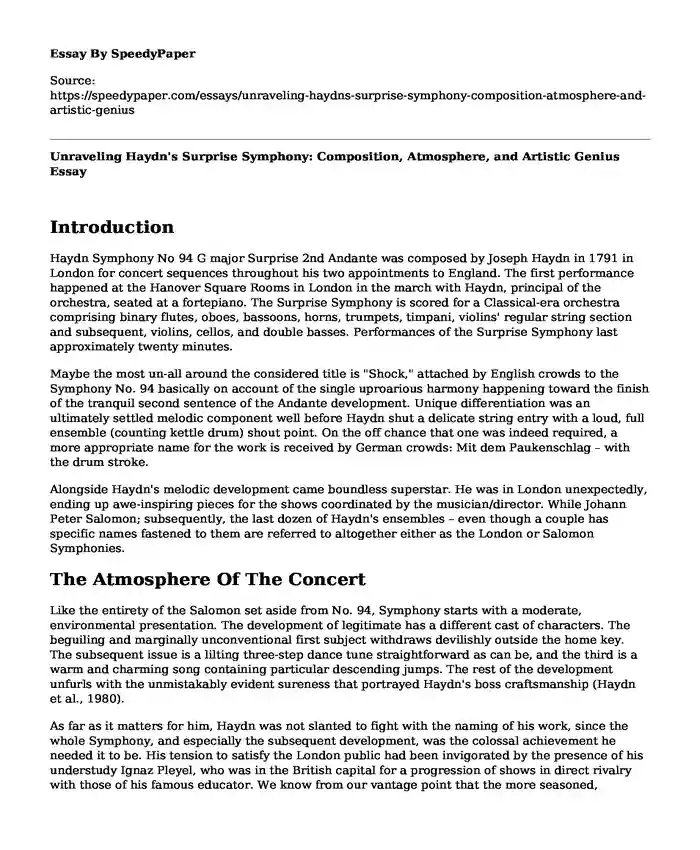Introduction
Haydn Symphony No 94 G major Surprise 2nd Andante was composed by Joseph Haydn in 1791 in London for concert sequences throughout his two appointments to England. The first performance happened at the Hanover Square Rooms in London in the march with Haydn, principal of the orchestra, seated at a fortepiano. The Surprise Symphony is scored for a Classical-era orchestra comprising binary flutes, oboes, bassoons, horns, trumpets, timpani, violins' regular string section and subsequent, violins, cellos, and double basses. Performances of the Surprise Symphony last approximately twenty minutes.
Maybe the most un-all around the considered title is "Shock," attached by English crowds to the Symphony No. 94 basically on account of the single uproarious harmony happening toward the finish of the tranquil second sentence of the Andante development. Unique differentiation was an ultimately settled melodic component well before Haydn shut a delicate string entry with a loud, full ensemble (counting kettle drum) shout point. On the off chance that one was indeed required, a more appropriate name for the work is received by German crowds: Mit dem Paukenschlag – with the drum stroke.
Alongside Haydn's melodic development came boundless superstar. He was in London unexpectedly, ending up awe-inspiring pieces for the shows coordinated by the musician/director. While Johann Peter Salomon; subsequently, the last dozen of Haydn's ensembles – even though a couple has specific names fastened to them are referred to altogether either as the London or Salomon Symphonies.
The Atmosphere Of The Concert
Like the entirety of the Salomon set aside from No. 94, Symphony starts with a moderate, environmental presentation. The development of legitimate has a different cast of characters. The beguiling and marginally unconventional first subject withdraws devilishly outside the home key. The subsequent issue is a lilting three-step dance tune straightforward as can be, and the third is a warm and charming song containing particular descending jumps. The rest of the development unfurls with the unmistakably evident sureness that portrayed Haydn's boss craftsmanship (Haydn et al., 1980).
As far as it matters for him, Haydn was not slanted to fight with the naming of his work, since the whole Symphony, and especially the subsequent development, was the colossal achievement he needed it to be. His tension to satisfy the London public had been invigorated by the presence of his understudy Ignaz Pleyel, who was in the British capital for a progression of shows in direct rivalry with those of his famous educator. We know from our vantage point that the more seasoned, limitlessly more talented author had nothing to fear from the effortless except for humbly enriched Pleyel, bound to be recognized as the originator of a celebrated piano plant. In any case, in London in 1791, Haydn worked long and difficult to introduce another Symphony that would please (Haydn, 1997).
The Andante subject of the subsequent development, of nursery tune effortlessness, is introduced by the strings delicately, rehashed by them considerably more delicately, and afterwards accentuated by The Chord. The four following minor departures from the subject are so apparently straightforward they require no portrayal. Notwithstanding, one can't neglect to specify the stunning coda. The breezes' fundamental issue takes on a magnificently Romantic tint through the provocative and dim harmonies in the strings.
Conclusion
To sum up, the Minuet third development is a genuine Austrian worker dance, however with a shockingly inconspicuous and noble Trio. The finale is 100-proof Haydn, this way creative, splendid, and songful, and loaded up with those turns, turns, and, indeed, remarkably consistent amazements, that solitary Haydn's virtuoso could flexibly.
References
Haydn, J. (1997). London symphonies (No. 93-98). Courier Corporation. https://www.amazon.org/Haydn-Philharmonic-Orchestra-Eugen-Jochum/dp/B000VGMCLI
Haydn, J., Hogwood, C., Nelson, J., & Salomon, J. P. (1980). Haydn's music for England. Folio Society. https://www.discogs.org/Franz-Joseph-Haydn-The-Academy-Of-Ancient-Music-Christopher-Hogwood-Haydns-Music-For-England/release/12425484
Cite this page
Unraveling Haydn's Surprise Symphony: Composition, Atmosphere, and Artistic Genius. (2024, Jan 15). Retrieved from https://speedypaper.com/essays/unraveling-haydns-surprise-symphony-composition-atmosphere-and-artistic-genius
Request Removal
If you are the original author of this essay and no longer wish to have it published on the SpeedyPaper website, please click below to request its removal:
- Metallica's Impact on Popular Culture, Music Essay Sample
- Apartment Design Plan in Our Free Essay Sample
- SWOT Analysis of Coach Inc - American Fashion Essay Example
- The House With The Ocean View and Other Artworks in a Free Essay Sample
- Free Essay with an Interview with Patricia Florina, Clothing Store Owner, and Manager
- Free Essay - Japanese Children's Drawings
- Free Paper Sample on Saint' Apollinare Nuovo
Popular categories





